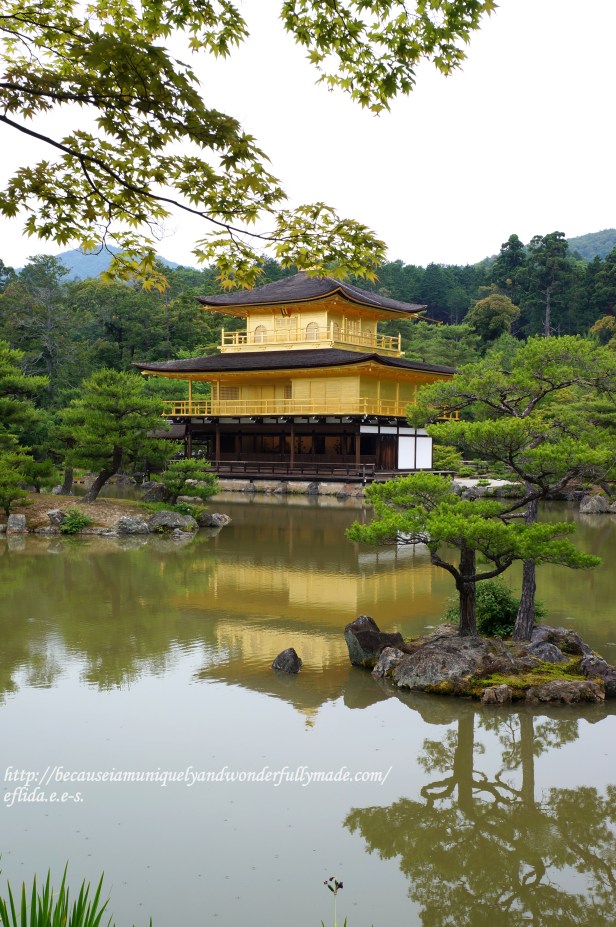Kinkaku-ji, which translates to Temple of the Golden Pavilion, is one of the most famous and most visited temples in Kyoto, Japan and having seen the temple myself made me understand why. Officially named Rokuon-ji or the Deer Garden Temple, Kinkaku-ji is designated as a National Special Historic Site and a National Special Landscape, and it is one of the 17 locations comprising the Historic Monuments of Ancient Kyoto World Heritage Site.
What makes this temple an extra must-visit is the Kinkaku, famously known as the Golden Pavilion. It is perhaps the most beautiful building in all of Japan and probably the most beautiful architecture I have seen. It is a three-story structure overlooking a pond, the top two floors of which are covered in thin sheets of golden leaf. Yes, you read that right. GOLDEN LEAF. The original structures were not as lavish as they are now considering the temple has been burnt numerous times by war and by arson by a monk in 1950. The building is not open for public viewiing but the first floor of Kinkaku houses the statues of the Shaka Buddha and Yoshimitsu while the second floor was patterned after samurai residences in Bukke style. The third and topmost floor is in Chinese Zen style capped with a golden phoenix.




Kinkaku-ji was originally a retirement villa in the late 14th century for Shogun Ashikaga Yoshimitsu and his will after his death indicated to convert the villa into a Zen temple of the Rinzai sect. The beauty of the temple’s landscape and garden is of minimal approach, making you think the place has just been ripped off from a magazine or some computer wallpaper coming to life. The place undoubtedly gives justice to the word breathtaking.

There is never a dull moment walking around the temple, something interesting will always catch your attention. There is the hojo, the former living quarters of the former head priest. There are also statues for coin toss and a beautiful view of the Anmintaku Pond that is said to never dry up with a mound of white snake called “Shirohebi no Tsuka” in the center. The “Shirohebi no Tsuka” was meant as a guardian deity though one legend says that one of the mistresses of the Shogun was deeply jealous of the others and threw herself into the pond, becoming a white snake.



A small but lovely waterfall called Toryumon or the Dragon Waterfall is a refreshing sight along the way, the name is based on a Chinese legend that any fish who can swim up a waterfall will turn into a dragon.

The Sekatei or tearoom is a reconstruction of the one built during the Edo Period and the oldest building left since the temple burnt down in 1950.

And just before you exit the temple, you can offer a prayer or a short meditation at Fudo Hall housing a statue of Fudo Myoo, one of the Five Wisdom Kings and protector of Buddhism.

Just like everyone else, I was wishing the pond at Kinkaku-ji was not there so I can touch the golden walls of the Golden Pavilion. But I took that back since the pond has a purpose to it. The name Kinkaku-ji has a word that means “mirror” and the pavilion’s reflection on the pond water makes it a beauty to marvel.

It is said that Kinkaku-ji is most beautiful to see in autumn or winter. It is still beautiful no matter what time of the year, regardless of the season. Fall foliage and snow flakes will add to its charm, true, but Kinkaku-ji is a spectacular beauty itself that has witnessed and survived the challenges of time. I will not mind another visit to this temple with my hubby though, again and again and again and again, any day of the year. *wink*



“thin sheets of golden leaf.” –> WOW!
Wow indeed Psyche. I cannot imagine anything as glamorous as that than the Taj Mahal but that is not fair to compare it with. Still, oh my goodness, literally a house made of gold! :)